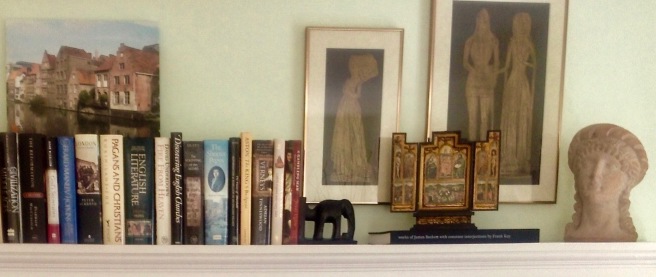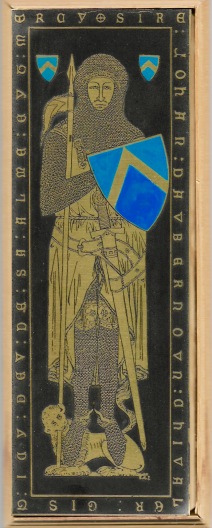
The line on the job application, paper in those days, asked “What are your hobbies?” I hesitated. The one piece of advice about job hunting I remembered from library school was “Never say your favorite hobby is reading.” Curious advice to give aspiring librarians, perhaps, but the idea was to avoid the impression you thought librarianship was just sitting around reading. You must project serious professionalism, information services not novel reading, people skills not shrinking violets hiding behind the covers of a book. But reading was in fact my hobby. Pretty much my only hobby. So I had to give the question some thought. Finally I wrote down brass rubbing.
Brass rubbing? I don’t mean polishing brass candlesticks or rubbing Aladdin’s lamp to conjure a genie. No, brass rubbing is the rather quaint English pastime of making copies of monumental brasses, engraved memorial images of the dead inlaid into church floors. This style of memorial was popular in England and parts of Europe from the thirteenth to the seventeenth centuries. They replaced the fashion for stone effigies atop tombs. About 8,000 monumental brasses survive in churches large and small throughout England. The copies are made by laying paper over the brass plate and rubbing with wax, the images gradually coming to life as if by magic. Traditional brass rubbing was done with black wax on white paper, but using gold wax on black paper gives a more beautiful brass-like image.

Now you might ask how I could legitimately claim to pursue this hobby when I lived an ocean away from English churches. Well probably the reason this answer popped into my head was that just weeks before I had visited an exhibit of monumental brass replicas at Washington National Cathedral. Following the exhibit the Cathedral sponsored brass rubbing workshops at community centers around the region. I attended a workshop and made three rubbings, gold on black. Two still hang in my living room and one, the figure of a gryphon, hangs in my youngest grandson’s bedroom. Making a brass rubbing from a replica instead of the original resulted in just as good an image and it was a lot easier to do. With the replica laid on a table you didn’t have to kneel on a hard stone church floor and crouch in a backbreaking position for hours.
I had tried it the hard way back in England. One summer I went on what we called a church-crawl in East Anglia, a region particularly rich in brasses. Church-crawl by day, pub-crawl by night. What a perfect vacation! I loved the spare aesthetic of Anglican country churches, not giving much thought at the time to the fact that it resulted from the Reformation era destruction and theft of the symbols of medieval Catholic piety, the statues and paintings and gold ceremonial objects that once filled these same churches. But many of the medieval brasses survived and the tradition continued in the post-Reformation era.

In fact much of the symbolism in monumental brasses is secular. A dog at the feet of a married couple is thought to represent faithfulness while heraldic symbols emphasize the status and lineage of the deceased. There are brasses of knights and their ladies, clergymen, merchants and other professions, and sometimes children with their parents. Because they are always dated monumental brasses are invaluable to historians, particularly for fashions in dress and military armor. But the popularity of brass rubbing and collecting brass rubbings is evidence that they are equally prized as works of art. I checked eBay and there are currently 265 brass rubbings for sale, some priced over $1,000. I shall hang onto mine for a rainy day!
All those years ago my job application was successful and I began my career as a librarian. Some time after I started work my supervisor told me that she had had two applicants to evaluate, with equal qualifications. She didn’t know how to choose between them. Then she noticed one listed her hobby as brass rubbing. She thought that sounded interesting and unusual so she offered me the job. I have no idea if the other applicant said her hobby was reading. But I was relieved to learn some months later that she was also hired. I had felt almost guilty getting the job on the strength of the pretentious sounding brass rubbing!
What I can say with certainty is that my excessive reading habit came in very handy in my work as a librarian. Brass rubbing was no help at all.



I have a full size brass rubbing of Eleanor de Bohun, Duchess of Gloucester but it is done on gold colored paper and the rubbing is white. Have you ever seen anything like this ? It was done in the early 70’s. On the back of the frame is written ” black wax”. Please let me know if you can help. It’s so hard to get a picture of because it’s behind plexi-glass and I keep getting reflections. Do you think it’s safe to take it out of the frame ?
Thank
LikeLike
Hi Sinder, first I must admit that I’m no expert on the identification and care of brass rubbings. I’ve never seen one white on gold but it sounds lovely! I had a problem with photographing my framed rubbings because of the glare but I just didn’t want to hassle with getting it out of the frame. I don’t think you could damage it unless as you try to get it out it seems stuck to the plexiglass. Then I would advise you stop. I recommend you contact the UK Monumental Brass Society for expert advice. Here’s the link, click the Contacts tab to send them your questions.
http://www.mbs-brasses.co.uk/brass_rubbing.htm
LikeLike
Thank you so much. I really appreciate the information and quick response. !
sinder
LikeLike
Thanks Rita, you are such fun to follow. Anne
LikeLike